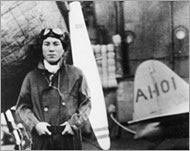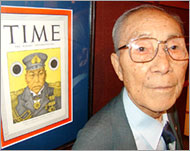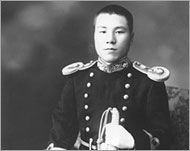Memories of Pearl Harbour
In the seconds before he released the 250kg bomb from his aircraft, Lieutenant Zenji Abe had blocked out all that was going on around him.

Bright tracer rounds were arcing up towards him, the air was whipping past the canopy and a tower of black smoke rose from where the USS Arizona was blazing out of control. But with another US warship in the crosshairs of his scope, nothing else mattered.
“All my concentration was focused on that scope, and I couldn’t think about anything else but the target,” says Abe, now 89 and – by his own admission – a wiser man than the daring pilot who at Pearl Harbour fired one of the first shots of the second world war in the Pacific.
“We had been training for this moment for months, and I was completely calm,” he says, punctuating his reminiscences with a folded paper fan.
“I was in the second wave of bombers, and many warships had already been damaged or sunk, so I chose a cruiser off the northeast side of Ford Island as my target.
“As we had practised, we approached the target at a 60-degree angle of attack and rising to a speed of 300kph when my navigator called for me to release at about 400m above the ship,” he says. “As soon as it was gone, I flattened out and we were about 30m above the harbour.
“But one thing that I never saw, when we were diving on the ship or as we moved away from the target area, was any people,” he says.
“The g-forces – which were up to six times gravity – meant I nearly blacked out and I had no peripheral vision for a minute or two, but I still don’t remember seeing any people, even though we were very low.”
Memories
He raises his eyes slightly as he re-examines the memories of 7 December 1941, but finally shakes his head.
 |
|
Zenji Abe on the flight deck of |
Abe did not know it at the time, but the three Aichi Type 99 “Val” aircraft that he led on the bombing run against the USS Raleigh worsened the damage caused by an aerial torpedo dropped a short while earlier, although the crew managed to keep the warship afloat and it was later repaired. None of the crew was killed.
Another part of the story that Abe only discovered after the war was that the attack was carried out before Japan had declared war against the United States.
At war
“I had always believed the attack was preceded by a declaration of war 30 minutes earlier,” he said. “When I did find out, I was extremely shocked and frustrated. I felt terrible regret. In war, surprise is a justifiable military tactic that is often effective, but it can only be justified if it is preceded by an official declaration of war.”
 |
|
Abe with the Time magazine that |
At the time, he says, he and his fellow pilots listened only to what the government was telling the Japanese people and things looked bleak for his homeland.
“When I look back, it appeared that Japan was in dire straits,” he says.
“We were surrounded by the ABCD line of America, Britain, China and the Dutch, and this was at a time when we had already been embroiled in a war in China for 10 years. Japan was exhausted; we had no crude oil, our assets overseas had been frozen, there was no iron and we all felt very much surrounded and that Washington was leading the pressure on us.
“It was a very dark time, and we felt that something had to happen – although no one ever thought that we would launch an attack on the US,” he adds.
Training
By the time he took off from the aircraft carrier Akagi, 260km north of the Hawaiian islands on the morning of the day that would “live in infamy”, according to US President Franklin Roosevelt, Abe had been a pilot for four years.
A graduate of the elite Imperial Naval Academy, he flew combat missions in China as Japan expanded its “co-prosperity sphere” and, after Pearl Harbour, was involved in raids on Dutch Harbour, in the Aleutian Islands, as well as carrier missions in the Indian Ocean, the Pacific and against targets in Australia. His navigator in the raid against Hawaii, Warrant Officer Chaiki Saito, was killed in the Marianas islands in 1942.
 |
|
Abe in ceremonial uniform before |
But his squadron was never as successful as it had been in December 1941.
“I had a feeling of great excitement as we took off from the Akagi and not worried about whether I would be able to return,” he says. Accompanied by nine Zero fighters and 17 other bombers, Abe took off at dawn and formed up alongside the attacking force from other carriers. The sea below was rough, he recalls.
He remembers his navigator confirming the task force’s commander giving the order to attack at 7.49am Honolulu time and hearing that the first wave of aircraft had caught the defending forces unaware.
Losses
He can picture the anti-aircraft fire and smoke rising over Hickam Field. He recalls being disappointed that there were no US aircraft carriers anchored in the harbour – a fact that would come back to haunt Japan – and bullets narrowly missing the aircraft. Within moments, he was giving a signal to his flight and the “Vals” peeled off for their attack runs. In all, he had been in the air two hours by the time his wheels touched down on the Akagi again.
A total of 351 Japanese aircraft had been used in the attack, of which 29 were lost. The US lost six battleships, three destroyers, three light cruisers, four other vessels and 164 aircraft. More than 2400 service personnel and civilians were killed.
US naval power in the Pacific had not, however, been crippled, and within two years Japan was on the defensive.
Desert island
Abe’s war was destined to end more than a year before Tokyo capitulated 60 years ago on 15 August. On 19 June 1944, after taking off from the aircraft carrier Junyo to carry out a long-range attack against US forces that were overwhelming the Japanese in the battle of the Philippine Sea, he was forced to crash land on the island of Rota when his fuel ran out. Cut off as American forces island-hopped closer to Japan’s home islands, he hid in a cave for more than a year before Tokyo announced surrender.
|
“When the war was finished, the Americans left us newspapers to find telling us of the surrender” Lieutenant Zenji Abe |
“There were about 1800 of us navy personnel on the island, and the Japanese forces tried to rescue us, but Guam to the south and Saipan to the north were both occupied by the Americans so it was impossible,” he says.
“When the war was finished, the Americans left us newspapers to find telling us of the surrender and broadcast radio news programmes over loudspeakers so we knew the emperor had surrendered.”
Going home
Repatriated in 1946, he joined the newly formed National Police Reserve and rose to head of the intelligence section before he retired in 1967.
Today, he lives with his wife and oldest daughter in Ibaraki Prefecture, north of Tokyo, but remains indignant at the failure of some of the top leaders who took Japan to war to take responsibility with their own hands.
“Two of my colleagues from the naval academy, relatively low-ranking officers who held positions such as destroyer captains, committed suicide at the end of the war to express their shame,” he says. “There were about 800 soldiers who took their own lives, but why did those who were later convicted of being Class-A war criminals not take the same step? Even today, that befuddles me.
“As soon as the emperor read out that Japan would surrender, the advisers who led us along this course in history should have turned to face the palace and offered their bones for giving bad advice,” he says. “Those who were the leaders and the heads of Japan’s armed forces should have committed ritual disembowelment.
“If they had taken their own lives, then at least it would have left a strong impression on the rest of the world of the Yamato spirit, that they had real bravery,” he says.
Fighting a new battle now, against cancer, Abe says that greater diplomatic efforts in the run-up to the attack on Pearl Harbour could have avoided bloodshed and laments the failure of young Japanese today to acknowledge what his generation lived through.
“Most Japanese people don’t know anything about Pearl Harbour,” he says. “In the United States, every time that December 7th comes around they make sure they remember. The differences between the two countries are vast.”